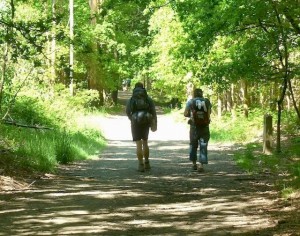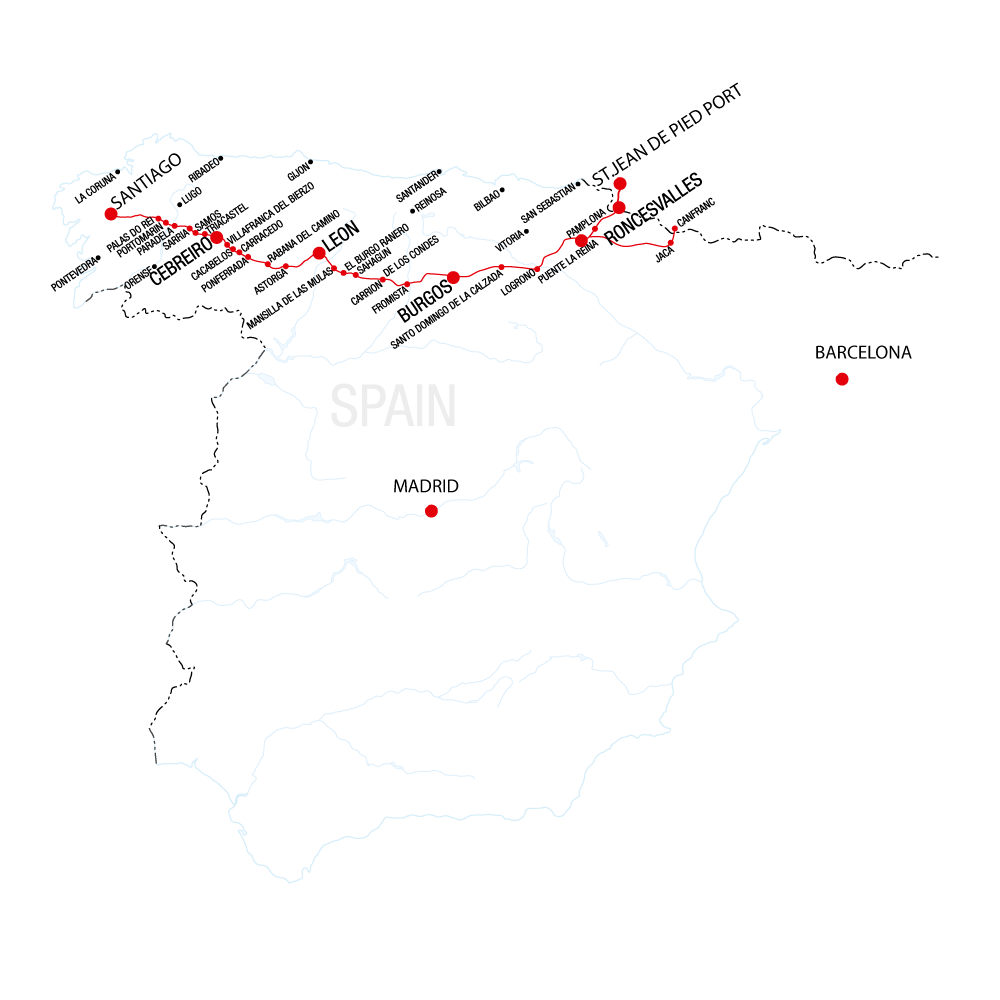The Camino Frances is the most well known and travelled pilgrimage route to Santiago.
The Camino officially starts in the Basque region at the foothills of the Pyrenees, in the delightful town of St Jean Pied de Port in France. The route stretches for almost 800km through the top of Spain to Santiago de Compostela.
One of the great things about the Camino is the variety of terrain you will encounter such as the mountains and the foothills of the Pyrenees, the beautiful vineyards of Rioja to farmland, rolling pastures and forests, through cities, towns, ancient villages and hamlets.
The Camino Terrain
Along the Camino there are:
- 505km of paths and tracks
- 203 Km of quiet roads, mostly through small villages
- 90 km of it runs along main roads
There are steeper sections, such as the lower ridge of the Pyrenees between St Jean Pied de Port and Roncesvalles which is at the start of the Camino. It is possible to skip this and start in Roncesvalles. There are also several mountains passes with altitudes of up to 1,500m around Astorga and before O’ Cebreiro.
The middle section of the Camino roughly from Burgos to Leon, while mostly at an elevation of around 800m, is actually nearly totally flat with just a few short steep inclines. This section is mostly featureless with fields stretching from horizon to horizon. It’s also the section where the elements can be harsh, with extreme heat in summer and extreme cold in winter. With virtually no cover throughout, this can really test walkers. It is, however, the section often attributed to the biggest Camino breakthroughs as walkers have no choice but to go within due to the lack of distractions.
See the elevation of the various stages along the route here.
Areas of the Camino
To help visualize such a long trail, the Camino Frances can be best thought of in 3 distinct sections:
- the rolling hills of the Basque country
- the hot, flat relatively empty section of the Meseta and
- the lush green hills and pastures of Galicia
The Camino passes through four regions and nine provinces:
- Navarra, Rioja, Castille & Leon and Galicia are the four regions
- Navarre, Huesca, Zaragoza, La Rioja, Burgos, Palencia, León, Lugo and A Coruña are the provinces.
You will take in the wonderful cities of Pamplona, Burgos, Leon and Santiago, with all their amazing architecture and cultural heritage along with the large and interesting towns of Logrono, Puente de la Reina, Astorga, Ponferrada, and Sarria, as well as numerous villages and ancient hamlets.
If you add in the wonderful food and drink of Spain, the hospitality and welcome you will receive, you can see that walking the Camino makes for an unforgettable journey.
Click the image below to enlarge.
The infrastructure of the Camino
You will pass through 141 different places and the majority of paths have been well maintained.
Usually, you are about 5-6 km from a grocery, café or bar for an essential pit stop where you can stock up, drink, eat or use the bathroom. Along the Peseta however, you will need to be well-stocked for the days walk ahead as the distance between places here can be up to 17km.
Walking the Camino is considered to be extremely safe as you are never too far from a town or village and with people from over 130 different countries walking the Camino you will meet people at each stage of the Camino.
Spain is suffering from high levels of youth unemployment so keep in mind that more care needs to be taken with your belongings in the cities.
Traditionally, accommodation on the Camino is in government-run or private albergues. Nowadays with the Camino attracting a variety of walkers, not just those on a pilgrimage, there is wonderful accommodation on offer, from fantastic historical buildings now turned into hotels known as Paradors, through to Casa Rurales and family-run hotels.
For those who worry about their ability to walk and carry all their belongings in a heavy rucksack don’t worry, you can get your main luggage picked up each morning and delivered to your next destination leaving you free to take in the scenery and enjoy your walk.
The 33 stages of the Camino
The Camino France is usually divided into 33 stages; this is arbitrary and each stage represents a day’s walk of roughly 24km. You can see the detail of each Camino stage here or download a destination guide on RAW Travel’s main site.
Camino Journey Options
If you are going to walk the full length of the Camino it is a good idea to allow about 40 days, this will allow for the average walk of approximately 24 km a day with time for rest days. These rest days can be taken in the major cities and large towns so that you can have a chance to explore these fascinating places. But don’t overdo the exploring, it is a rest day!
If you don’t have the time to walk the full length consider doing one of the shorter trips, the first or last 100km or a start a bit further afield from O Cebrerio.
Another option would be starting in one of the major cities, Pamplona, Burgos or Leon and cycle the Camino. All of these trips can be scheduled for any amount of days to suit your requirements.
You can, of course, do it in a shorter time by cutting down on the rest days, although this is not recommended. An increasingly popular thing to do is to bike over the meseta, the long flat stretch across the middle, therefore cutting down the length of time needed for the overall journey.
See the tours section for details of these itineraries.









